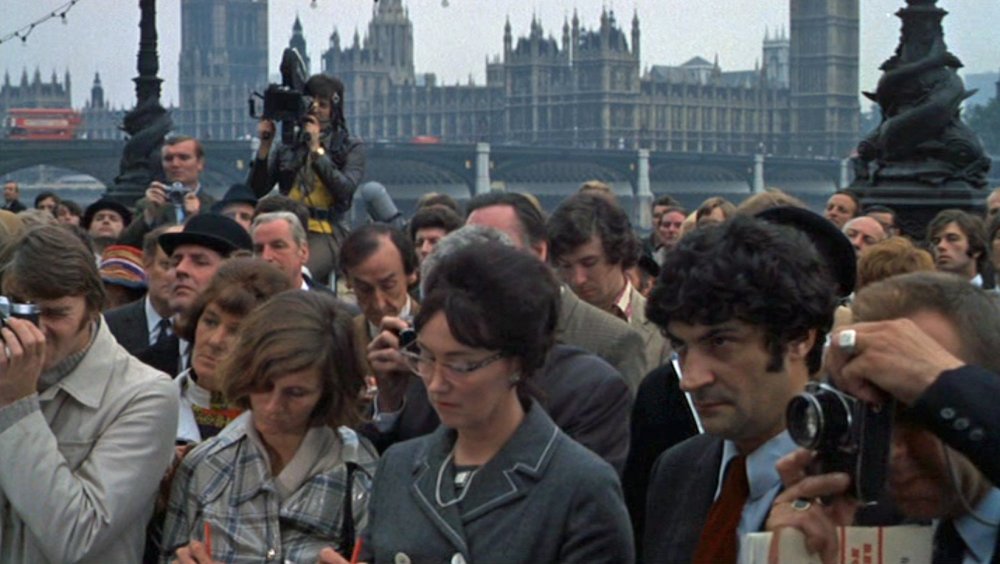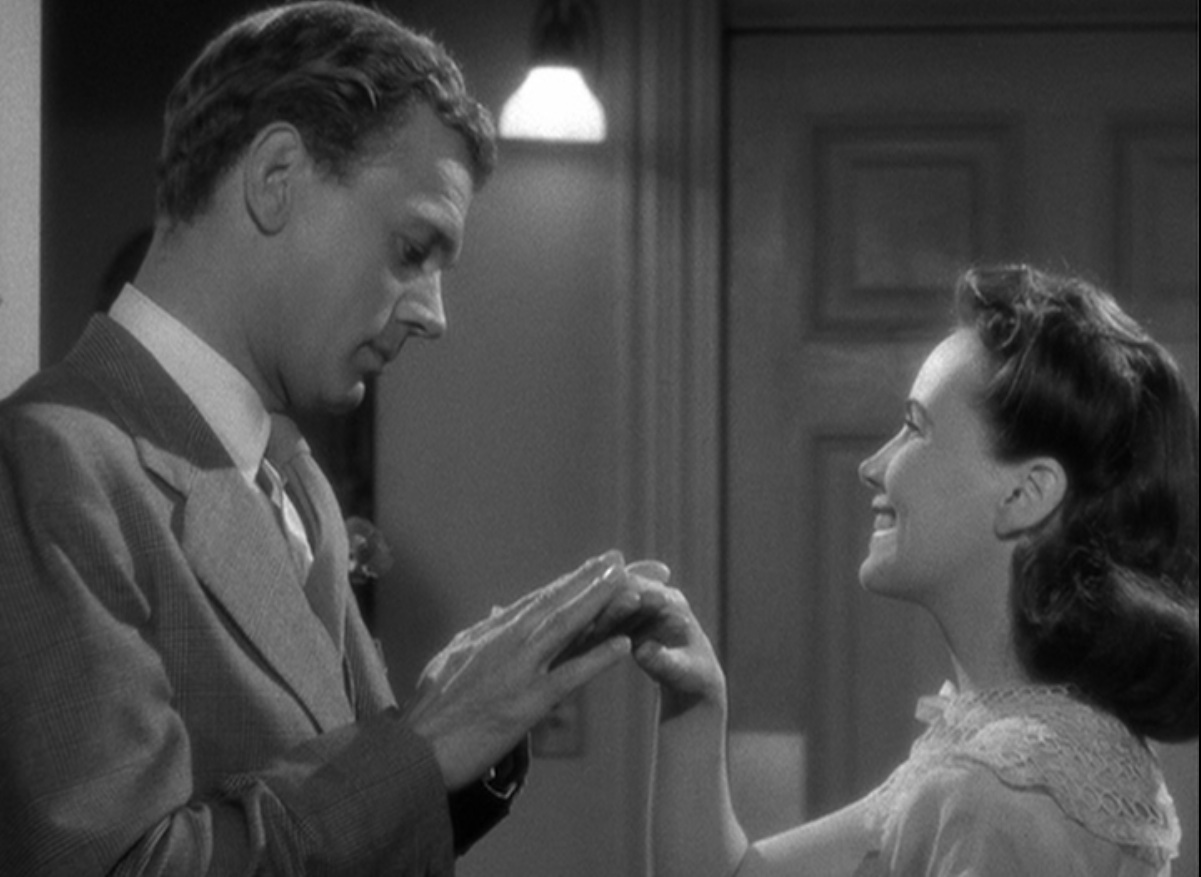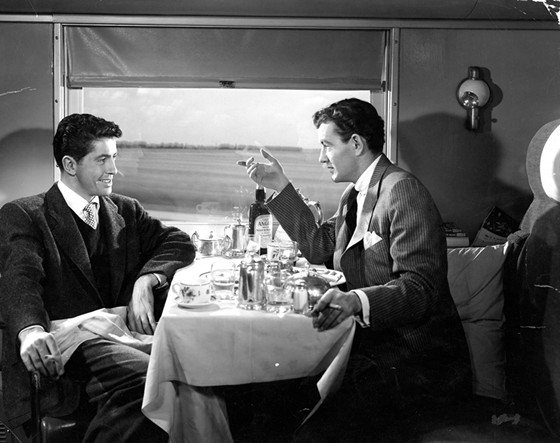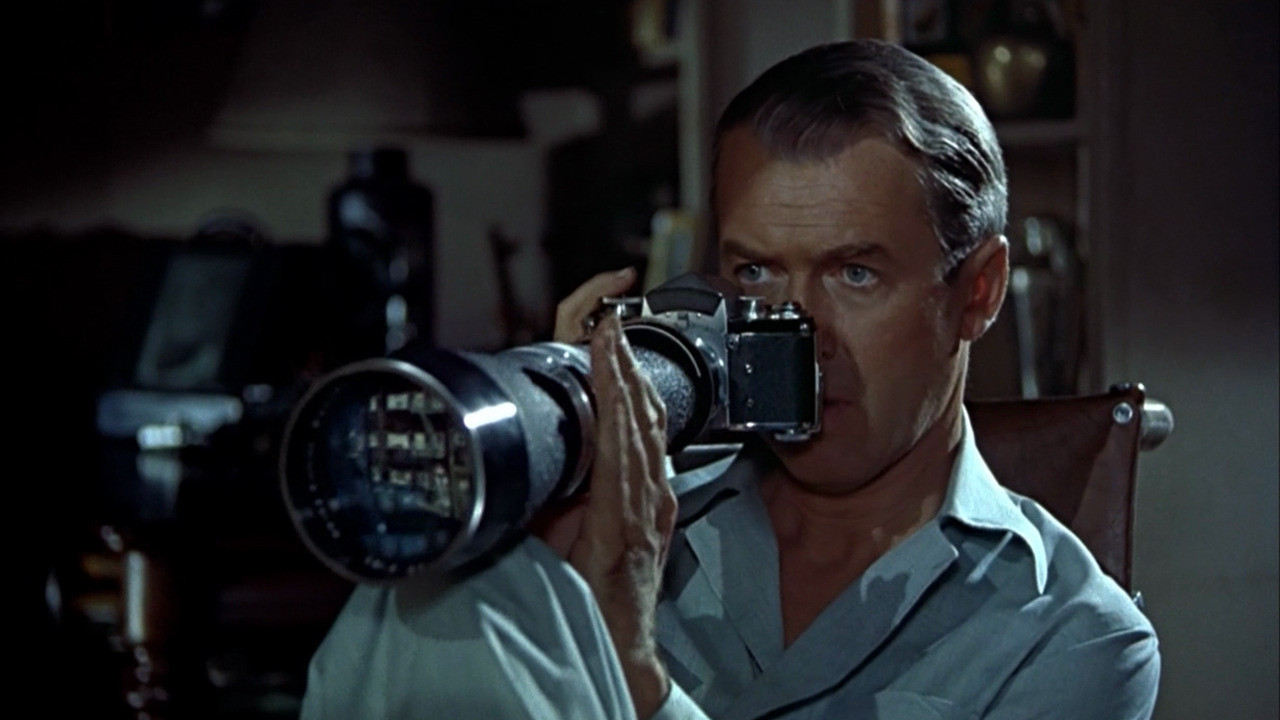8. Frenzy (1972)

After three disappointments in a row in the mid to late 1960’s, many felt that Hitchcock’s career was over. Although scholars were beginning to take Hitchcock more seriously by the time Frenzy was released in the summer of 1972, it had been over a decade since he had made a film that connected with the public in a big way. But Frenzy was a major success for the director and was universally hailed as a return to form.
Returning to his familiar theme of a man falsely accused, Richard Blaney (Jon Finch) is wanted for a series of vicious necktie murders actually committed by Blaney’s friend Bob Rusk (Barry Foster).
Eventually Police Inspector Oxford (Alec McGowan) figures out that the police have caught the wrong man, but not before Rusk brutally murders barmaid Babs (Anna Massey) in a scene that features one of Hitchcock’s greatest shots, the uninterrupted crane shot backwards of the camera moving out into the street as Rusk and Babs walk up the stairs to his apartment where she will be murdered.
Hitchcock took advantage of the new relaxed censorship by showing ample violence and nudity in the film, a tactic that surprised some. But Frenzy is most notable for the way Hitchcock implicated his audience in Rusk’s horrific crimes, by linking the killer together with the falsely accused ‘innocent’ protagonist, Blaney, as if they are two of a kind. Frenzy is a dark descent into the mind and methods of a psychotic killer and is also Hitchcock’s great late period triumph.
7. Marnie (1964)
Hitchcock originally intended to film Winston Graham’s novel as the follow up to Psycho, featuring Grace Kelly in her return to the screen as the problematic heroine. But, after expressing interest, the Princess of Monaco pulled out of the project and Hitchcock abandoned it, returning to it after The Birds with new star Tippi Hedren in the lead.
Hitchcock changed the structure of the film from the novel, in which two male rivals fight for the interest of Marnie, instead casting heartthrob Sean Connery as Mark Rutland, who captures kleptomaniac thief Marnie after she has robbed his company safe and forces her to marry him. Diane Baker is Lil Mainwaring, who competes with the reluctant Marnie for Mark’s affections.
A complex psychological character study, Marnie features Hitchcock’s most complicated and creative use of color, suggesting Marnie’s state of mind through various palette changes throughout the film. The film also borders at times on the surreal, as the female protagonist struggles to maintain her sanity despite troubling dreams and occasions of emotional upset; indeed, the film seems to have highly influenced the 1966 film Belle de Jour by Spanish surrealist master Luis Bunuel.
The final sequence of the film, in which Marnie flashes back to the childhood trauma that has caused her problems (check out Bruce Dern in an early appearance as the sailor who briefly comes between Marnie and her mother) is a tour de force, as the guilty secret is revealed to both Mark and the audience.
Featuring fine performances by Hedren, Connery, Baker and Louise Latham as Marnie’s mother, Marnie was originally decried by critics as ‘Hitch-cock and bull’ and received indifferently by audiences, but after both Robin Wood and Donald Spoto wrote critical reappraisals in their books, the film grew vastly in reputation. This is a must see and essential viewing for anyone who wants to understand the films of Alfred Hitchcock.
6. Strangers on a Train (1951)
In the late 1940’s, Hitchcock went into a commercial slide, with four films in a row that failed at the box office. Setting aside his newly formed production company, Hitchcock signed a production deal with Warner Brothers and produced one of his greatest films, based on the debut novel by mystery writer Patricia Highsmith.
Farley Granger is Guy Haines, tennis star and aspiring politician who has left his unfaithful wife, Miriam for the beautiful Ann Morton (Ruth Roman), daughter of a U.S. Senator. Guy meets Bruno Anthony (brilliantly played by Robert Walker) as strangers on a train, and Bruno suggests to Guy they “swap murders”: Bruno will kill Miriam while Guy murders Bruno’s hated father.
Each has killed a total stranger and thus has no apparent motive. But when Bruno goes ahead and murders Miriam, he then expects the hapless Guy to fulfill his part of the bargain, and the rest of the film features a classic Hitchcock dual structure, as Guy is pursued by both Bruno and the police.
Strangers on a Train is notable for the way that Hitchcock adroitly handled the ‘doubling’ motif of the exchange of good and evil; Bruno is Guy’s dark underside, acting out and fulfilling the murderous fantasies that Guy can only half-heartedly joke about.
The ‘double’ theme recurs again and again in the film, from the opening shots of the two men’s feet as they arrive at the train station and eventually bump into each other, to the interwoven dual train tracks, playing doubles tennis, drinking ‘doubles’ and finally encountering other strangers on the train. Strangers on a Train became one of Hitchcock’s best known and loved films, popular with audiences and critics alike, a classic example of a merging of form and content and the director at the very top of his game. Doubles, anyone?
5. Shadow of a Doubt (1943)

Hitchcock frequently told interviewers that Shadow of a Doubt was his personal favorite film, and it is not hard to understand why. Based on a story idea by writer Gordon McDonnell (which was loosely based on a true incident), Shadow of a Doubt is the story of an innocent young woman, Charlie Newton (Theresa Wright) whose Uncle Charles (Joseph Cotton) comes to stay with her and her family in the scenic all American town of Santa Rosa.
But Uncle Charles is actually the cold blooded “Merry Widow Murderer” who is being pursued by the police and as the evidence against him piles up, his distraught niece eventually realizes the truth. A life and death struggle between the two ensues, as young Charlie tries to get her Uncle to leave town before the police nab him and her beloved mother realizes the shocking truth about her brother.
Shadow of a Doubt is filled with numerous references to Hitchcock’s own life and childhood, and so it is not surprising the personal interest that he took in the film. Filmed largely on location in Santa Rosa, which was unusual for the time, Hitchcock took the opportunity to create a number of breathtaking and inventive shots with which to tell his story.
As often happens in Hitchcock, the movie opens with young Charlie bemoaning the boredom and predictability of her life, but as her world is shaken by the revelations about her Uncle, the young girl wishes she had her predictable and safe life back given the danger that has befallen her.
The film also is another re-working of the ‘good and evil’ double theme, as under the threat of her Uncle, young Charlie must look within herself to find the evil and darkness that gives her the capability to murder her Uncle. A modest success at the time, Shadow of a Doubt is a film that is essential to understanding the innovative film genus that was Alfred Hitchcock.
4. Vertigo (1958)

After French director Henri-Georges Clouzot had success with Diabolique, writers Boileau and Narcejac wrote the novel D’entres Les Morts with the intention that it be made into a film by Hitchcock. James Stewart is Scotty Ferguson, a police detective who retires after a colleague falls trying to rescue him.
Coaxed out of retirement by Gavin Elster (Tom Helmore) to watch his wife, Madeleine (Kim Novak) who appears to be acting under the influence of a dead relative, Scotty falls in love with Madeleine despite the intervention of his longtime friend Midge (Barbara Bel Geddes). When Madeleine appears to kill herself by leaping from a mission tower, Scotty loses his mind, only to later encounter Judy Barton (Novak) whom he attempts to remake into his lost love.
The film features some of Hitchcock’s greatest shot making, including the now famous ‘track in zoom out’ shot of the mission tower steps as Scotty looks down dizzily (reused by many filmmakers, including Steven Spielberg in Jaws) and the amazing shot of Judy emerging from the fog of her apartment bathroom re-made as Madeleine. Vertigo is a story of obsession, longing and romance, as Scotty follows Madeleine through the hilly, beautiful streets of San Francisco.
Originally considered a misfire on its release, Vertigo was shown occasionally on TV until the early 70’s when, like the mysterious Madeleine, it disappeared. Hitchcock himself owned the rights to the film by this point and pulled it from public viewing until his death in 1980. With Vertigo unavailable, its critical fortunes began to rise as Robin Wood praised the film as a masterpiece and Donald Spoto called it Hitchcock’s greatest film in his 1977 book The Art of Alfred Hitchcock. In 1983 the film was finally re-released to an eager public, which viewed it with a new eye.
Vertigo was also the first Hitchcock film to be fully restored in 1996, although restorers Katz and Harris were criticized for replacing some of the foley soundtrack with new sound effects. Finally, in 2012, Vertigo topped the Sight and Sound Critic’s Poll as the number one film of all time, surpassing Citizen Kane.
The story of Vertigo a bit too unconvincing and convoluted to consider it to be even Hitchcock’s best, but there is no doubt that the beautiful visual style of the film, the glorious use of colors and the masterful mix of location and soundstage footage is Hitchcock working at his highest level.
3. Rear Window (1954)
The richest period of Hitchcock’s filmmaking begins with his move to Paramount studios in 1953, where the first film he made was Rear Window. Taken from a short story by Cornell Woolrich, Rear Window is the story of photographer L.B. Jeffries who has broken his leg and, cooped up in his Greenwich Village apartment, comes to suspect his neighbor, Thorwald (Raymond Burr, made up to look like Hitchcock’s old boss, David Selznick) of murdering his invalid wife.
Pressured by his attractive girlfriend Lisa (Grace Kelly) to marry her and settle down as a fashion photographer, each of the windows that Jeffries looks into becomes in some ways a potential future for himself and Lisa: the sexually active newlyweds, the bland middle aged couple, the frustrated composer, the oddball sculptor, Miss Lonelyhearts, Miss Torso the dancer and finally the Thorwalds themselves.
A meditation on voyeurism and living vicariously through the lives of others, Rear Window connected deeply with audiences on its initial release and became one of Hitchcock’s most popular and enduring films, eventually influencing several generations of filmmakers including Antonioni (Blow Up, 1967), Coppola (The Conversation, 1974) and DePalma (Body Double, 1984) as well as the more recent Disturbia (2007).
Featuring great supporting acting from Thelma Ritter as Jeffries’ sarcastic nurse (at one point she muses “Ah, we’ve become a race of Peeping Toms…what people ought to do is get outside of their houses and look in for a change!”) and Wendell Corey as the skeptical police detective, Rear Window features a great script by John Michael Hayes, who worked with Hitchcock on four of his finest films in the mid 1950’s before the two went their separate ways.
The subject of a lengthy lawsuit over copyright of Woolrich’s original story, the film was pulled by Hitchcock from public viewing for over a decade before finally being re-released to acclaim with Vertigo in 1983. A definite must see for film buffs in general and Hitchcock buffs in particular.
2. North by Northwest (1959)
Screenwriter Ernest Lehman told Hitchcock that he wanted to write ‘the ultimate Hitchcock picture’ and, boy, he sure did. North by Northwest features another of Hitchcock’s falsely accused men on the run, this time Cary Grant as ad man Roger Thornhill, who has become entangled with some spies and is framed for the murder of a U.N. diplomat. Featuring James Mason as Phillip Vandamm, one of Hitchcock’s best and most evil bad guys, Eva Marie Saint as Eve Kendall, the beautiful double agent and Martin Landau as Leonard, Vandamm’s dangerous sidekick,
North by Northwest functions both as an entertaining suspense chase picture as well as a deep meditation on the meaning of life, love and identity. Thornhill must confront all that is false about him, including his charming, glib exterior and his fascicle, meaningless life, to look down deep inside himself when faced by the danger and challenges posed in the course of the film, eventually coming out the other side as a fully realized human being, capable of love and commitment.
A reworking of The Thirty Nine Steps as well as Hitchcock’s less successful Saboteur (1942), North by Northwest became one of the director’s greatest and most influential films, as well as featuring his best known ‘MacGuffin’ – the microfilm with government secrets on it hidden in a sculpture purchased at a Chicago art auction. The director frequently climaxed his films with sequences in familiar or theatrical settings, and he originally conceived of the film by imagining characters running around across the Mount Rushmore monument (even considering the working title “The Man in Lincoln’s Nose”).
The film’s grand finale on Mount Rushmore does not disappoint, and North by Northwest ends up being the Hitchcock film that succeeds on every level. Made at MGM, where Hitchcock had a unique one picture deal while still under contract at Paramount, North by Northwest has never been out of circulation and photographed in beautiful Vista-vision, it is now available on blu-ray.
1. Psycho (1960)
The ultimate Hitchcock film? Perhaps the ultimate film…period?!? By the late 1950’s, Hitchcock realized that the competition was moving up on him, particularly producer/director William Castle, who made several low budget successes in the horror genre at that time. Deciding that even a relatively low budget horror film made by a truly talented filmmaker would be very successful, Hitchcock took Robert Bloch’s plot rich novel Psycho and, along with screenwriter Joseph Stefano, created a truly remarkable film.
Marion Crane (Janet Leigh) runs away from Phoenix with $40,000 stolen from her employer to be with her boyfriend, the cash strapped Sam Loomis (John Gavin). But a rainy detour to the Bates Motel run by Norman Bates (Anthony Perkins in a career defining role) ends up with Marion hacked to death in Hitchcock’s best known scene of all time, the shower murder. Who did it? Jealous Mother Bates? Hitchcock kept the now well-known surprise ending as much of a surprise as he could, and the brilliantly orchestrated publicity campaign ended up with a massive box office that ensured the director’s financial well-being as well as his career legacy.
Psycho destroyed and reconstructed so many film conventions that it is difficult to name them all here. Film techniques employed by Hitchcock in Psycho that still are used commonly today include the quick cutting of the shower sequence, the cutting between objective-subjective points of view in Lila’s approach to the Bates house, the camera moving from a birds eye point of view to the inside of a hotel room in the film’s opening, the extreme close up of Norman’s eye as he looks through a peephole at Marion undressing and the use of 50 mm lens to give a ‘realistic’ point of view.
The meeting of Marion Crane and Norman Bates, though, is at the heart of the film and their parlor conversation that precedes the shower murder is one of Hitchcock’s most brilliantly constructed scenes, both on a level of script writing and shot making.
In Psycho, the dead rule the living, as Marion’s sister, Lila (Vera Miles) discovers as she walks through the Bates home, with each room getting creepier and creepier. Hitchcock hid a deep, dark secret in the fruit cellar, and when Lila discovers that secret, it shocked the film world to the core. Hitchcock noted it was a “fun” picture and a bit like taking the audience on a tour of the spook house at a carnival.
Nothing would ever be the same and, eventually, Psycho spawned two sequels in the 1980’s, a 1990 ‘prequel’, a 1998 ‘shot for shot’ remake by director Gus Van Sant and a recent A & E television series, Bates Motel. As an exercise in film technique and brilliant story-telling, Psycho has never been matched. The culmination of Hitchcock’s career, Psycho marked a commercial high point and, while some critic’s didn’t like the film on first release, most eventually came around to admiring the film.
Author Bio: Jim Davidson is a 1980 graduate of Northwestern University’s Radio-TV-Film Dept. He lives in the San Francisco Bay Area and has been a video producer since 1987. Jim has written articles for Images Film journal and is currently working on a book about the movie Harold and Maude.




